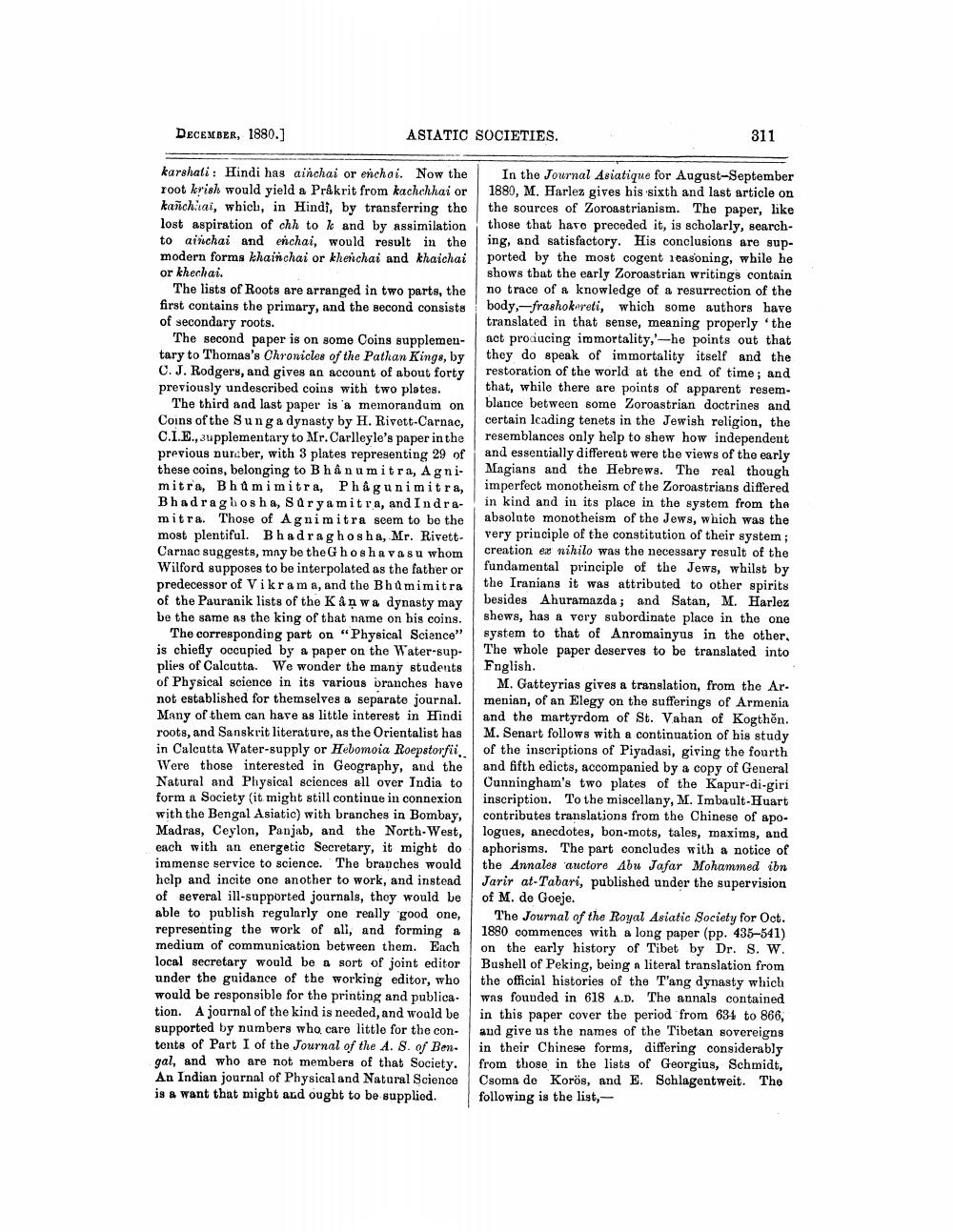________________
DECEMBER, 1880.]
karshati: Hindi has ainchai or enchai. Now the root krish would yield a Pråkrit from kachchhai or kanchai, which, in Hindi, by transferring the lost aspiration of chh to k and by assimilation to ainchai and enchai, would result in the modern forms khainchai or khenchai and khaichai or khechai.
ASIATIC SOCIETIES.
The lists of Roots are arranged in two parts, the first contains the primary, and the second consists of secondary roots.
The second paper is on some Coins supplementary to Thomas's Chronicles of the Pathan Kings, by C. J. Rodgers, and gives an account of about forty previously undescribed coins with two plates.
The third and last paper is a memorandum on Coins of the Sunga dynasty by H. Rivett-Carnac, C.I.E., supplementary to Mr. Carlleyle's paper in the previous number, with 3 plates representing 29 of these coins, belonging to B hâ nu mitra, Agnimitra, Bhumimitra, Phagunimitra, Bhadraghosha, Suryamitra, and Indramitra. Those of Agnimitra seem to be the most plentiful. Bhadraghosha, Mr. RivettCarnac suggests, may be the Ghoshavasu whom Wilford supposes to be interpolated as the father or predecessor of Vikrama, and the Bhumimitra of the Pauranik lists of the Kan wa dynasty may be the same as the king of that name on his coins.
The corresponding part on "Physical Science" is chiefly occupied by a paper on the Water-supplies of Calcutta. We wonder the many students of Physical science in its various branches have not established for themselves a separate journal. Many of them can have as little interest in Hindi roots, and Sanskrit literature, as the Orientalist has in Calcutta Water-supply or Hebomoia Roepstorfii,, Were those interested in Geography, and the Natural and Physical sciences all over India to form a Society (it might still continue in connexion with the Bengal Asiatic) with branches in Bombay, Madras, Ceylon, Panjab, and the North-West, each with an energetic Secretary, it might do immense service to science. The branches would help and incite one another to work, and instead of several ill-supported journals, they would be able to publish regularly one really good one, representing the work of all, and forming a medium of communication between them. Each local secretary would be a sort of joint editor under the guidance of the working editor, who would be responsible for the printing and publication. A journal of the kind is needed, and would be supported by numbers who care little for the contents of Part I of the Journal of the A. S. of Bengal, and who are not members of that Society. An Indian journal of Physical and Natural Science is a want that might and ought to be supplied.
311
In the Journal Asiatique for August-September 1880, M. Harlez gives his sixth and last article on the sources of Zoroastrianism. The paper, like those that have preceded it, is scholarly, searching, and satisfactory. His conclusions are supported by the most cogent reasoning, while he shows that the early Zoroastrian writings contain no trace of a knowledge of a resurrection of the body, frashokereti, which some authors have translated in that sense, meaning properly the act producing immortality,'-he points out that they do speak of immortality itself and the restoration of the world at the end of time; and that, while there are points of apparent resemblance between some Zoroastrian doctrines and certain leading tenets in the Jewish religion, the resemblances only help to shew how independent and essentially different were the views of the early Magians and the Hebrews. The real though imperfect monotheism of the Zoroastrians differed in kind and in its place in the system from the absolute monotheism of the Jews, which was the very principle of the constitution of their system; creation ex nihilo was the necessary result of the fundamental principle of the Jews, whilst by the Iranians it was attributed to other spirits besides Ahuramazda; and Satan, M. Harlez shews, has a very subordinate place in the one system to that of Anromainyus in the other, The whole paper deserves to be translated into English.
M. Gatteyrias gives a translation, from the Armenian, of an Elegy on the sufferings of Armenia and the martyrdom of St. Vahan of Kogthen. M. Senart follows with a continuation of his study of the inscriptions of Piyadasi, giving the fourth and fifth edicts, accompanied by a copy of General Cunningham's two plates of the Kapur-di-giri inscription. To the miscellany, M. Imbault-Huart contributes translations from the Chinese of apologues, anecdotes, bon-mots, tales, maxims, and aphorisms. The part concludes with a notice of the Annales auctore Abu Jafar Mohammed ibn Jarir at-Tabari, published under the supervision of M. de Goeje.
The Journal of the Royal Asiatic Society for Oct. 1880 commences with a long paper (pp. 435-541) on the early history of Tibet by Dr. S. W. Bushell of Peking, being a literal translation from the official histories of the Tang dynasty which was founded in 618 A.D. The annals contained in this paper cover the period from 634 to 866, and give us the names of the Tibetan sovereigns in their Chinese forms, differing considerably from those in the lists of Georgius, Schmidt, Csoma de Korös, and E. Schlagentweit. The following is the list,




